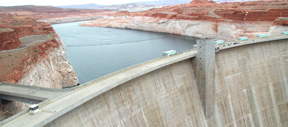Utah’s Water Future
Utah water development legislation and Colorado River accord bolster Utah’s future water supplies.
LeRoy W. Hooton, Jr.
March 27, 2006
|
Utah’s population is expected to double during the next forty plus years. According to the State Water Plan based on these population projections and current per capita usage, the state will experience an 800,000 acre-foot shortfall in water supply. In order to meet the state’s population growth rate it will be necessary to both develop and save water. Water conservation and efficiencies goals will reduce the shortfall to 400,000 acre-feet. Water development through the Lake Powell Pipeline Project, Bear River Project, agriculture conversions to M&I water, secondary systems and wastewater reuse will make up the remaining 400,000 acre-foot shortfall.
A number of bills passed by the 2006 Legislature will help in meeting the state’s future water supply needs. H.B. 45 amended the Bear River Act to allow preconstruction activities; H.B. 47 removes the present cap on state sales tax dollars earmarked for water development projects and specifies that 94 percent of the additional monies pay for certain preconstruction cost of the Bear River and Lake Powell Pipeline projects; and S.B. 27 authorized the Board of Water Resources to build the Lake Powell Pipeline Project.
These legislative acts seem to settle the issue of how the state will finance its water projects. During Governor Leavitt’s administration there was a concerted effort to eliminate using sales tax revenues for financing state water development programs and replacing it with a surcharge on retail municipal water rates. Placing a surcharge on water bills would have been devastating to local water entities across the state, impairing their ability to finance their own operation and maintenance and capital improvements programs.
The recent drought precipitously lowered the water levels of both Lake Powell and Lake Mead, heightening concern over the management of these storage facilities if the drought resumes or to cope with future droughts. Last year Interior Secretary Gale Norton challenged the seven basin states to negotiate a Lower Basin Shortage Guidelines agreement. With encouragement from Interior and realization that conflict and litigation may not bode well for the river’s water users, representatives from the seven basin states struck an agreement and forwarded it the Secretary on February 3, 2006.
The agreement requires Lower Basin water use reductions amounting to between 400,000 and 600,000 acre-feet a year to lessen the impact on Powell and Mead water levels during drought periods. Specified water elevations of the two reservoirs trigger the use reductions. Utah’s Larry Anderson said that with the options of either having Interior develop a shortage plan and/or protracted litigation to decide the matter, the seven states were motivated to negotiate their own agreement. Anderson felt that the agreement will enhance Utah’s recreational benefits of Lake Powell by maintaining higher levels in the lake during drought periods.
Interior Assistant Secretary for Water and Science Mark A. Limbaugh speaking at a WEF/AWWA conference in Salt Lake City characterized the agreement as important to the management of the Colorado River as the 1922 Compact.
With its unbridled growth rate, Las Vegas seems to be the 900 pound guerilla in Colorado River geopolitics, followed by populous southern California. Besides trying to acquire additional water from the Colorado River, the Southern Nevada Water Authority (SNWA) representing communities in the Las Vegas valley is planning a large-scale groundwater development program reaching northward upstate to White Pine and Lincoln counties. SNWA plans to drill wells and construct a conveyance system to develop 180,000 acre-feet of groundwater. It is believed that this project without safe yield constraints will affect Utah water users located across the border in Snake and Spring valleys. (General site description: South boundary the Great Basin National Park to the north boundary Callao, Utah long both sides of the Utah – Nevada border.)
Lt. Governor Gary Herbert indicated that the State of Utah will protect its citizens’ water, but expressed a willingness to cooperate with Nevada to the extent possible. The trade-off may be SNWA’s promise to support the Lake Powell Pipeline Project and not exert claims to water in the Virgin River, which is part of the Lower Basins water allocation under the compact. Water Resources director Larry Anderson said he supported Nevada’s efforts to develop instate groundwater rather than Las Vegas looking northward for additional Colorado River water in the Upper Basin or challenging the compact.
Dean Baker, a rancher from Baker, Nevada, seems to be the lone voice opposing the SNWA groundwater development project. “It morally wrong to ship this water to southern Nevada,” he said. However, he quipped that his views were not welcome in southern Nevada. SNWA officials claim that they will balance the interests of those affected by the groundwater project.
It is clear that water will continue to be a major issue in Utah and the West as the population continues to grow in this region of the United States.
Return to Home Page: http://www.slcclassic.com/utilities/
